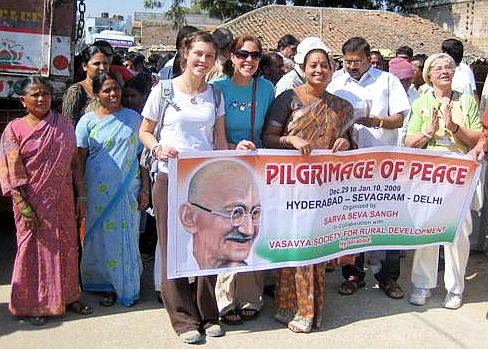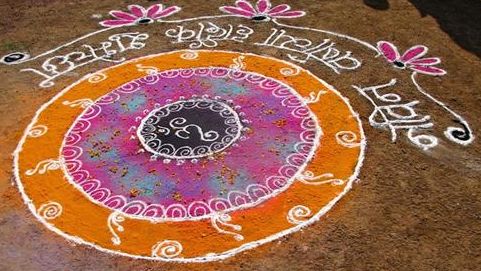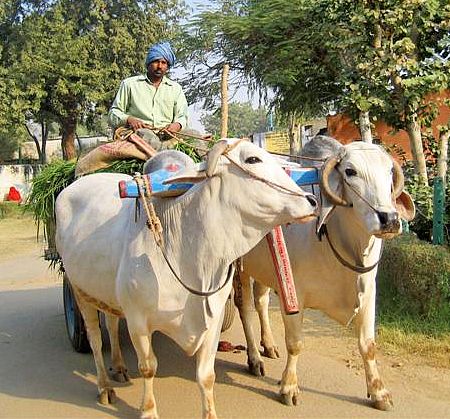(A letter sent by Dianne Henke, a pilgrim, to family and friends.)
PILGRIMAGE OF PEACE TO INDIA
December 27, 2008 – January 10, 2009
A Pilgrimage: No matter how short the distances and familiar the route you travel on a given day, you can do it as a pilgrim—and no matter how long the journey or how sacred the destination, it is possible to be nothing more than a tourist. We embark on this Pilgrimage to India with a desire to experience the Divine, present in the spirit and work of Gandhi and in the people, culture and land of India.



Dear Friends and Family,
Since many of you may not have the opportunity to visit India in your lifetime and would like to gain some insight about the country from someone you know I will share my impressions of India gleaned in two weeks during my Pilgrimage to India. If you decide to put this letter aside without reading it, I understand completely. For those who continue, this is my gift to you from India.
Wonder: India bursts with the energy of more than a billion people. That is 4 times the population of the US in a space almost 3 times smaller. Milwaukee feels like a retreat center in comparison to the large cities of India. Never before have I understood what a billion people feels like: the energy, the sounds, the color, the bicycles, the motorbikes, the rickshaws, the 3 wheeled taxies, the cars, the trucks, the buses, the dogs, the cows, the “hawkers”, the vegetable stands, the vendors, the children, the beautiful saried women. To a westerner’s eye, at first it looks chaotic, but soon you sense the order, like the movement of a flock of birds or a school of fish; so many people moving to their destinations without traffic lights, stop signs, designated travel lanes or accidents, as far as I witnessed; a beautiful synchronism, which baffles the inexperienced.
Since this was a pilgrimage, the eleven of us traveled without expectation, but open to whatever was prepared for us. Prasad Gollanapalli, a Gandhian scholar and our host, had arranged for us to experience the depth of hospitality of the Indian people, especially that which his Gandhian colleagues show to people who come as friends to meet them, learn from them and join them in bringing peace to the world. We were treated like royalty. We were adorned with leis, shawls, a Bindi (beautiful red mark placed between the eyebrows) and asked to share who we were and invited to experience what it means to follow Gandhi. The Gandhian scholars are academics who, like Gandhi, have chosen lives of simplicity, dedicating their energy to spreading the principles of Gandhi.
The Gandhian principles which we were most deeply introduced to during this pilgrimage were:
We participated in a march celebrating a new well with potable water, which was achieved by organizing the people in the community. This public witness honored Gandhi and showed the benefits of active service.
Two highlights on the pilgrimage were 3 days at Sevagram, Gandhi’s Ashram and 2 days at Vandanya, Vandana Shiva’s center. Both places were retreat-like and gave us space to process what we were experiencing. At the Ashram, which is located near the very center of India, we felt very close to Gandhi as we walked through his hut and prayed where he prayed under the tree he planted in 1936. One interesting aspect of the prayer service, which is said nightly, was that after praying a Hindu prayer and some other prayers they say the “Our Father” in English. Gandhi believed that faith in God is the foundation of all moral values. It felt good to be able to join in the prayer service with a prayer we knew.
Navdanya is located in the foothills of the Himalaya Mountains which border Tibet/China. The center’s mission, as described on the website, says it is “to promote peace and harmony, justice and sustainability. We strive to achieve these goals through conservation, renewal and rejuvenation of the gifts of biodiversity we have received from nature and our ancestors, and to defend these gifts as commons. The setting up of community seed banks is central to our mission of regenerating nature’s and peoples’ wealth. Keeping seeds, biodiversity and traditional knowledge in people’s hands to generate livelihoods and provide basic needs is our core programme for removal of poverty.”
Vandana Shiva is a physicist and activist who started Navdanya “to promote alternatives to non-sustainable agricultural technologies based on toxic chemicals and genetic engineering.” They “are committed to changing the rules of unfair trade forced on small peasants through the WTO (World Trade Organization) Agreement on Agriculture, which has led to destitution, debt and farmer suicides.” Over 100,000 farmers have committed suicide in India over the past 20 years, 17,000 in 2003 alone.
We toured the beautiful farm, seed bank and medicinal plants. The work being done there is inspirational. Vandana is in high demand as an international speaker and was out of the country while we were at Navdanya. I had brought to India the movie, “FLOW”, which describes the water crisis in the world and was an official selection at the 2008 Sundance Film Festival. We were able to view it at Vandanya which was apropos since Vandana Shiva was in the film as an outspoken critic of transnational corporations’ connection to the water crisis in India.
After Navdanya we headed to the sacred Ganges River at Rishikesh. There we participated in a beautiful Hindu ceremony with lots of orange clad monks chanting as we lit fragrant bowls of flowers and floated them down the Ganges with our prayers. This was a meaningful way for me to bid farewell to India.
Challenges: According to “About.com: Geography”, a NY Times Co. website, India’s population in 1947 was 350 million, very close to the current US population of 300 million. It has more than tripled since then and is expected to grow to 1.5 billion by 2030. India’s population is growing faster than any other country in the world and will soon have more people than China.
India has over a billion people and according to the World Bank 800 million live on less than $2.00 a day. According to Aseem Shrivastava the figure of $2.00 a day is misleading. For countries like India because of the purchasing power disparities it is more accurate to say they are living on less than 40 cents a day. Only 27 million households earn more than $5,000 a year according to the “State of the World’s Wealth: 2006” published by Merrill Lynch and French consulting firm Capgemini. That leaves 373 million living on between 40 cents a day and $5,000 a year; add the 800 million living on less than 40 cents a day and India has a billion people who are extremely poor.
Here’s a way to visualize this: When I visited The Sisters of Charity home for abandoned and dying children in Haiti in 2004, we entered a room the size of a classroom with about 40 cribs. We were there to rock the babies. I rocked my baby the size of an emaciated 18 month old while tears streamed down my face. Then I was asked to feed the baby and was given a bowl with mush-like cereal. I put the spoon to the baby’s mouth, parted his lips and found a full set of teeth. This child was not 18 months, as I had thought, but three or four years old. He refused to eat. It seemed all he wanted to do was die.
There were 40 cribs in Mother Teresa’s sisters’ home in Haiti. A parishioner from St. Anthony’s on the Lake in Pewaukee just returned from visiting The Sisters of Charity in Kolcutta, India. She said in the room she visited there were 1,000 cribs. The scale of poverty is overwhelming.
Hope: When seeing face to face the overwhelming amount of poverty in India I was flooded with a sense of freedom. The realization hit me that no matter what I did I could never, personally, change the reality of all these people. It deflates the ego and demands trusting in a Loving God. I now understand why Mother Teresa chose to do one thing when she began her ministry: pick up the dying and provide a death with dignity—nothing more, nothing less. She changed herself and found a way to live authentically with the poorest of the poor trusting God that it was enough if done with Love.
All I can do is change myself. How can I live in solidarity with the poor of this world? What can I do to live in a way that promotes, what Gandhi calls, “the welfare of all”; not the welfare of a few at the expense of the many or the welfare of many at the expense of a few, but the welfare of ALL.
I can choose to align myself with the Gandhian scholars and others in India who have given up comfort and wealth to address the plight of the poor through community and creativity. I can trust the God of Love to lead me, and it will be enough if done with Love.
“The earth can provide for the needs of all but not for the greed of any.” Gandhi
Blessings of Peace,
Dianne Henke
P.S. If you want to learn more about future pilgrimages to India, please let me know at or 1–262–695–9000.
i www.mkgandhi.org., “The Ideal and the Actual in Gandhi’s Philosophy by B.S. Sharma
ii Ibid.
iii www.navdanya.org Mission Statement
iv Ibid.
v Ibid.
vi Aseem Shrivastava has a doctorate in Economics from the University of Massachusetts of Amherst and does research on issues connected with globalization in India. www.pej.org